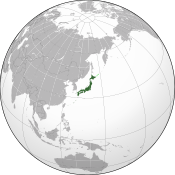Japan raises severity level of crisis; efforts to cool damaged nuclear power plant continue
Friday, March 18, 2011

As the nuclear crisis in Japan's crippled Fukushima I Nuclear Power Plant appears to worsen, Japan’s nuclear safety agency raised their assessment of its severity from 4 to 5 on the 7-level International Nuclear Event Scale, the same rating given the 1979 Three Mile Island crisis. Japan's Prime Minister, Naoto Kan, said bluntly that the situation at the nuclear power plant was "very grave". Weather forecasts indicate changing winds may begin moving radiation closer to Tokyo by March 30.
Efforts thus far to cool nuclear fuel in the reactors and the spent-fuel pools has produced little if any success, contends United States government officials.
Engineers are working frantically to connect electrical power to two reactors in the plant, as well as to restart the cooling systems and prevent overheating of fuel rods. Tokyo Electric Power Co. stated that it hopes to reconnect a power line needed to restart water pumps to the No. 1 and No. 2 reactors by Saturday morning. However, a TEPCO official cautioned that if the water pumps were damaged by the tsunami, they could fail to restart.
The extent of the damage to the plant's reactors is still unclear. Japanese officials have concentrated on cooling spent fuel rods in Reactor No. 3's storage pool. On Friday, however, steam was seen rising from Reactor No. 2., where an explosion occurred on Tuesday. Additionally, engineers said on Thursday that the steel lining of the storage pool at Reactor No. 4 and its concrete base seemed damaged, as attempts to refill the pool with water became increasingly difficult.
In a briefing on Friday, Philippe Jamet, a commissioner at France's nuclear regulator Autorite de Surete Nucleaire, said, "We must avoid being overly optimistic. This will likely take human intervention like going into control rooms to reconnect valves."
Sources
- By Hiroko Tabuchi and Keith Bradsher. "Frantic Repairs Go On at Plant as Japan Raises Severity of Crisis" — The New York Times, March 18, 2011
- Sachiko Sakamaki and Jonathan Tirone. "Japan Nuclear Crisis Remains ‘Very Grave’ as Forecasts Show Shifting Winds" — Bloomberg, March 18, 2011
External links




